
Ghent is a city and a municipality in the Flemish Region of Belgium. It is the capital and largest city of the East Flanders province, and the third largest in the country, exceeded in size only by Brussels and Antwerp. It is a port and university city.
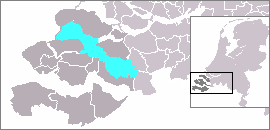
The Eastern Scheldt is a former estuary in the province of Zeeland, Netherlands, between Schouwen-Duiveland and Tholen on the north and Noord-Beveland and Zuid-Beveland on the south. It also features the largest national park in the Netherlands, founded in 2002.

The Scheldt is a 350-kilometre-long (220 mi) river that flows through northern France, western Belgium, and the southwestern part of the Netherlands, with its mouth at the North Sea. Its name is derived from an adjective corresponding to Old English sceald ("shallow"), Modern English shoal, Low German schol, West Frisian skol, and Swedish (obsolete) skäll ("thin").

Zuid-Beveland is part of the province of Zeeland in the Netherlands north of the Western Scheldt and south of the Eastern Scheldt.
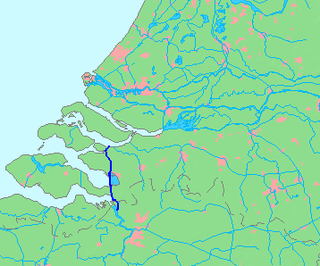
The Scheldt–Rhine Canal (Schelde-Rijnkanaal) in Belgium and the Netherlands connects Antwerp with the Volkerak, and thereby the Scheldt with the Rhine.

Philip Fruytiers (1610–1666) was a Flemish Baroque painter and engraver. Until the 1960s, he was especially known for his miniature portraits in watercolor and gouache. Since then, several large canvases signed with the monogram PHF have been ascribed to him. These new findings have led to a renewed appreciation for his contribution to the Antwerp Baroque.

St. James' Church is a former Collegiate church in Antwerp, Belgium. The church is built on the site of a hostel for pilgrims to Santiago de Compostela. The present building is the work of the Waghemakere family and Rombout Keldermans, in Brabantine Gothic style. The church contains the grave of Peter Paul Rubens in the eastern chapel.
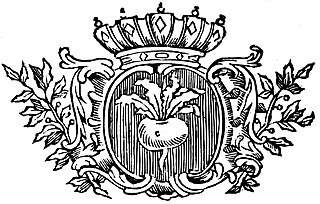
The Waasland is a Belgian region. It is part of the Belgian provinces of East Flanders and Antwerp. The other borders of the Land van Waas are with the Scheldt and Durme rivers. The (informal) capital and major city of the region is Sint-Niklaas.
The Zuid ("South") in Antwerp is a currently fashionable area of Antwerp. Revived in the mid-1980s, it has an attractive street plan and a few Art Nouveau buildings, such as the former Volkshuis on the Volkstraat, but which now houses the Rudolf Steiner school. Three museums, numerous commercial art galleries, fashionable cafes and restaurants, two arts' centres and a sprinkling of up-market shops add to the attractions of the area.

The Diocese of Antwerp is a Latin Church ecclesiastical territory or diocese of the Catholic Church in Belgium. The diocese was restored in 1961. It is a suffragan in the ecclesiastical province of the metropolitan Archdiocese of Mechelen-Brussels. Its cathedra is found within the Cathedral of Our Lady.

St. Andrew’s Church is a Catholic church in Antwerp built in the 16th century. Its exterior is mainly characterised by a late-Gothic style while its interior is predominantly executed in Baroque style. It is the parish church of the Parish of St. Andrew’s. During the nineteenth century the St. Andrew's Parish was known as the parish of misery as it was by then mainly populated by poor people.

Johannes van Mildert or Hans van Mildert was a Flemish sculptor, who is best known for his baroque sculptures found in many Belgian and Dutch churches. Van Mildert played an important role in the development of the design of Flemish Baroque religious furniture.

The St. Paul's Church or Sint-Pauluskerk is a Roman Catholic church located at the Veemarkt in Antwerp. Its exterior is mainly Gothic with a Baroque tower while the interior is characterised by its rich Baroque decoration. It holds paintings by Antwerp's leading artists Peter Paul Rubens, Anthony van Dyck and Jacob Jordaens as well as abundant sculpture and church furniture crafted by leading Antwerp sculptors such as Artus Quellinus the Elder, Pieter Verbrugghen I, Jan Pieter van Baurscheit de Elder, Jan Claudius de Cock and Andries Colyns de Nole. Of particular note is the Calvary outside the Church which is made up of 63 life-size statues and nine reliefs executed in a popular and theatrical style.

The St Walburga Church in Antwerp, Belgium, formerly a parish church, was demolished in 1817.

John Gaspar Gevartius or Jan Caspar Gevaerts (1593-1666) was the jurisconsult of Antwerp and in his lifetime a famous philologist. He was a personal friend of Peter Paul Rubens.

Huibrecht, Hubrecht, Hubertus or Hubert van den Eynde was a Flemish sculptor. He is mainly known for his religious sculptures and church furniture although he also worked on some secular projects. He was the first prominent sculptor of the van den Eynde family of artists and merchants. In the early 17th century, van den Eynde was one of the leading Flemish sculptors who rejected contrived Mannerist formulae in favour of greater realism. His work shows a development from the early Baroque to the high Baroque. His late style is characterized by a penchant for movement and dashing draperies.

Lodewijk Willemsens or Ludovicus Willemsens (1630–1702) was a Flemish sculptor from Antwerp. His works comprise mostly sculptured church furniture, and to a lesser extent individual sculptures, both portrait busts as well as statues of saints for churches.

Sebastiaen van den Eynden was a Flemish sculptor. He is mainly known for his religious sculptures and church furniture although he also worked on some secular projects. He was a member of the van den Eynde family of artists and merchants.
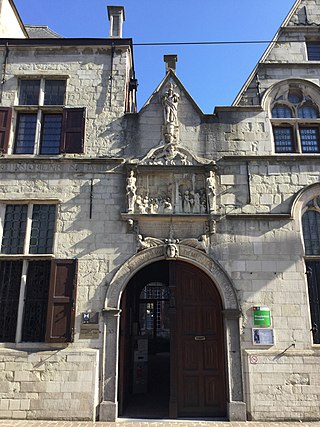
The Maagdenhuis Museum is an art museum and historical museum located in a 17th-century historic building on Lange Gasthuisstraat, Antwerp, Belgium. The building was used as an orphanage for the maegdeckens, or maidens, from the mid-16th century to the end of the 19th century. The museum presents a collection of utensils used on a daily basis by the foundlings and the orphans; a collection of antique furniture, and a series of documents relating to the orphanage and the life in it from the 16th century to 19th century.
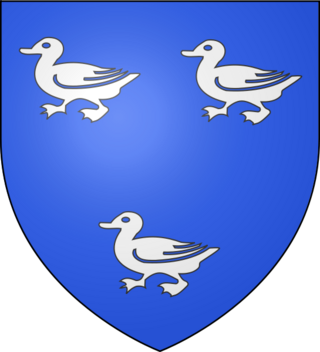
Van den Eynde is the name of an old Netherlandish noble family. One of the earliest recorded Van den Eynde to use the three-duck canting arms was Jacob van den Eynde, first Councilor and pensionary of Delft, and the highest official in the county of Holland. The Van den Eynde became especially prominent in 16th-century Delft, 17th-century Antwerp and Naples.




















